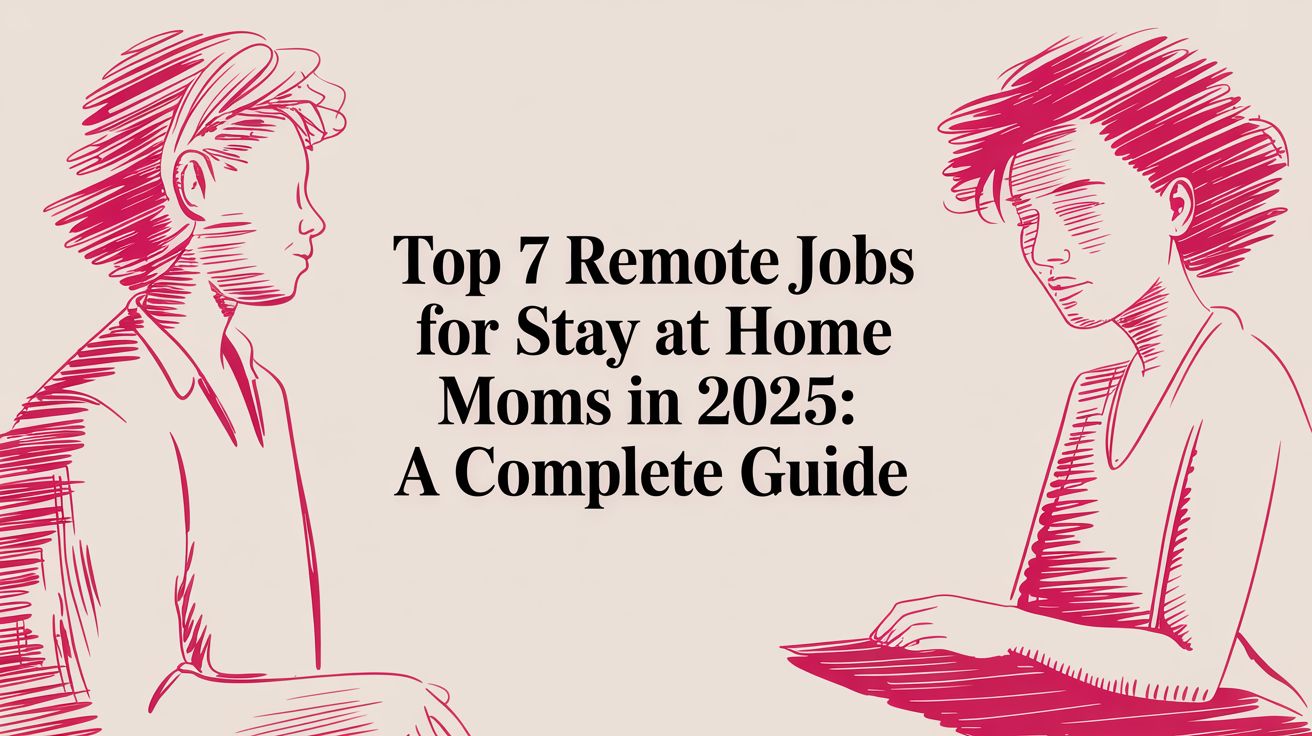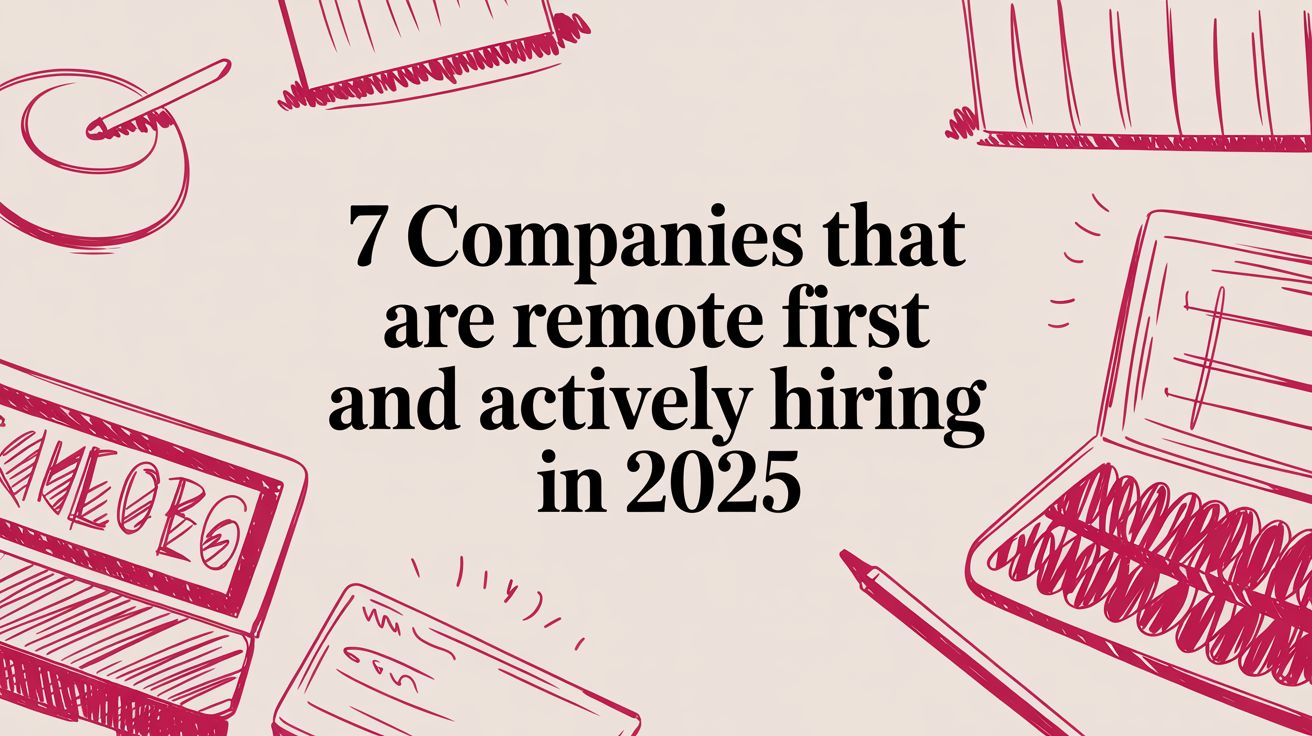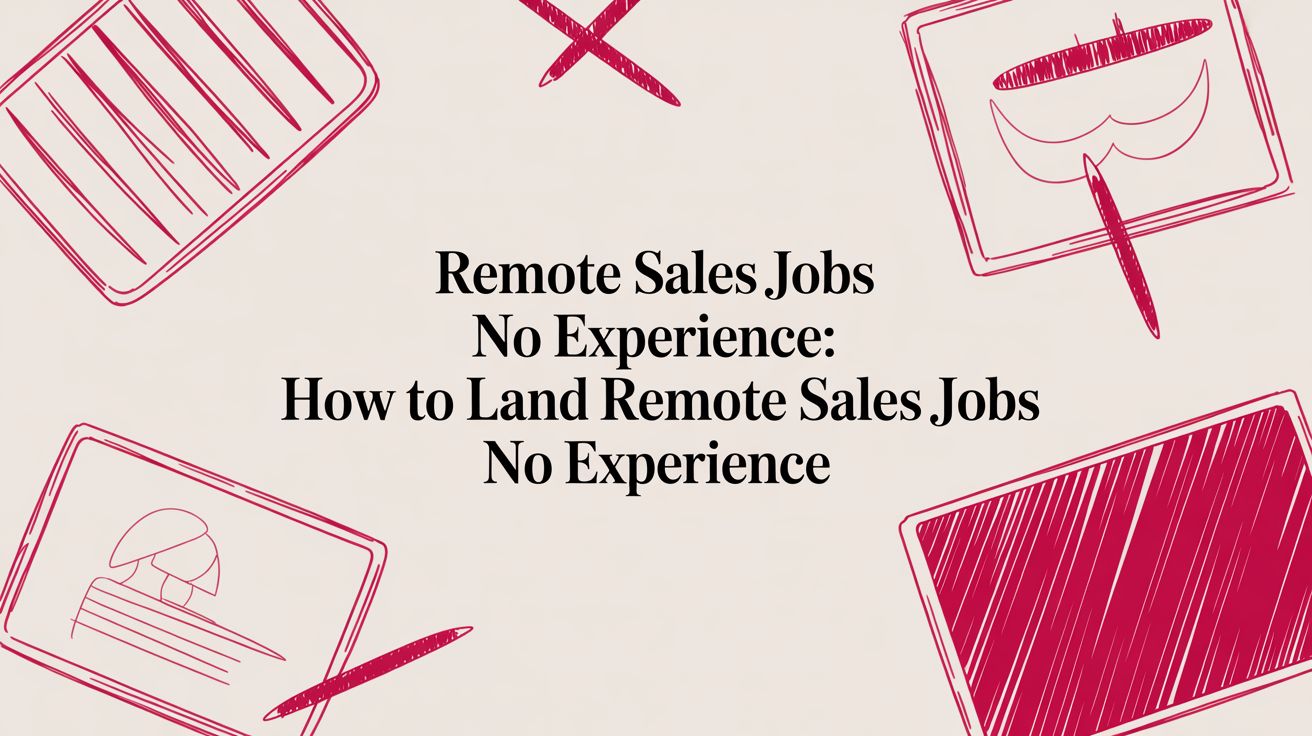how to answer conflict interview questions: Quick tips
Max
Answering questions about conflict isn’t about proving you were right. It’s about showing how you solve problems. Think of it as telling a story where you’re the calm, collaborative hero. A structured approach like the STAR method is your best friend here, as it helps you demonstrate emotional intelligence and a focus on getting to a good outcome.
Why Interviewers Ask About Conflict
Let’s get one thing straight: when a hiring manager asks about conflict, they’re not looking for juicy office gossip. It’s a calculated move to gauge the soft skills that don’t show up on a resume. And of course, to even get to this stage, your resume first needs to beat ATS systems and land more interviews so a real person actually sees it.
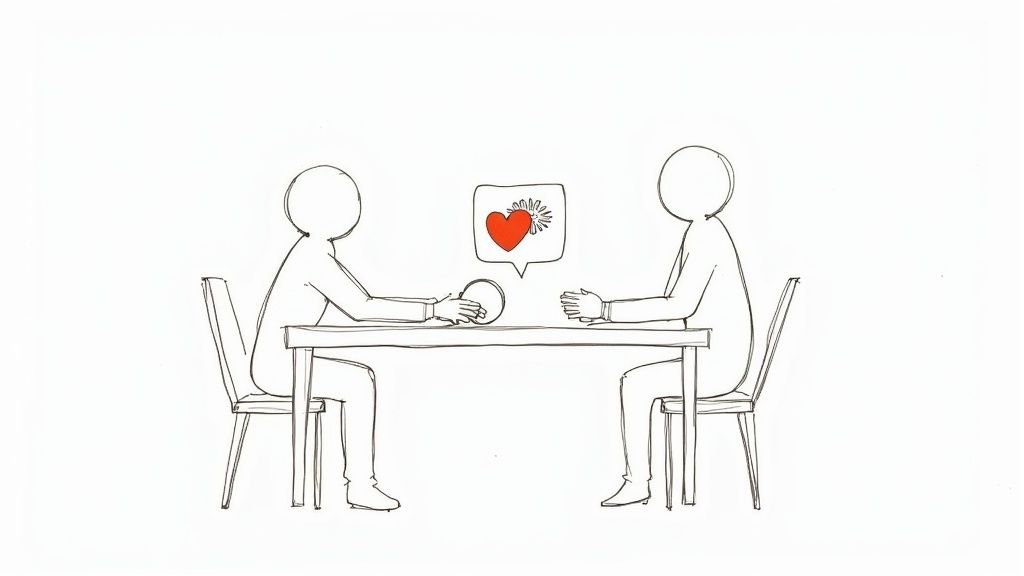
How you answer gives them a peek into your professional maturity and what you’d be like as a teammate. A great response can turn what feels like a trick question into a moment where you really shine.
What They Really Want to Know
Hiring managers are digging for specific traits when they toss these questions your way. They’re trying to see if you have:
- Emotional Intelligence: Can you keep your cool, really listen to what someone else is saying, and manage your own feelings when things get tense?
- Problem-Solving Skills: Do you jump to finding a solution, or do you get bogged down in placing blame?
- Communication Abilities: Are you able to share your point of view respectfully while also hearing others out?
- Teamwork Orientation: When push comes to shove, do you put the team and the company’s goals first?
Since nearly 85% of employees deal with conflict at work, interviewers know it’s a part of any job. They just want to see if you have the maturity to handle it constructively. Behavioral questions like these are also staples in remote interviews, so it pays to review other common remote job interview questions that test these skills.
Ultimately, they aren’t just filling a seat. They’re looking for someone who will add to a positive and productive work environment.
Mastering The STAR Method For Conflict Stories
When an interviewer asks you to describe a time you handled a disagreement at work, a rambling story just won’t cut it. You need a clear, compelling narrative that shows you’re a pro at navigating tough situations. This is where the STAR method comes in—it’s hands-down the best tool for structuring your answer.
Think of it as a simple framework that transforms a potentially messy anecdote into an impactful story that hiring managers can easily follow. It keeps you on track and laser-focused on the skills they actually care about.
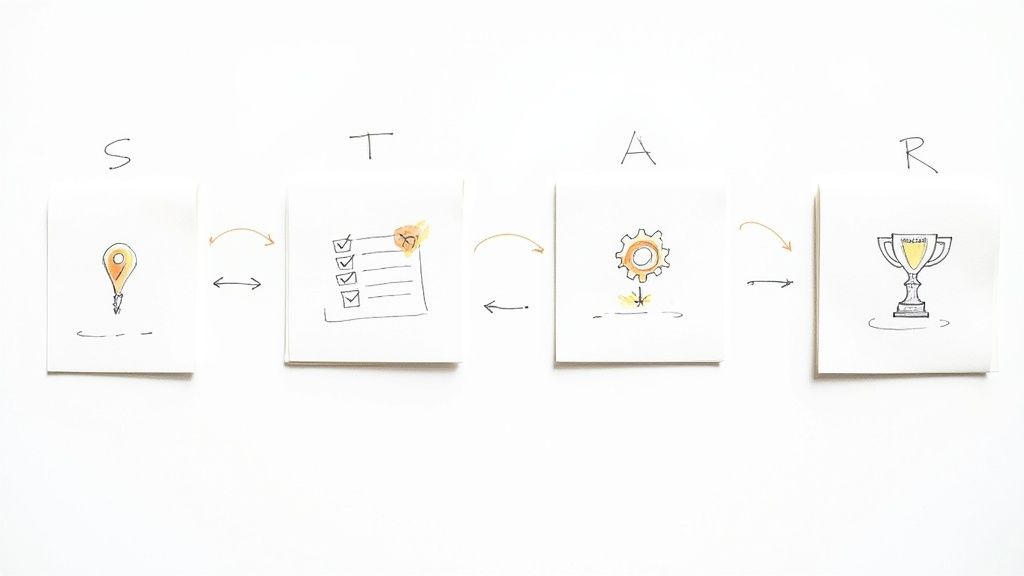
The acronym stands for Situation, Task, Action, and Result. Each piece of the puzzle is critical for painting a complete picture of your professional maturity and knack for solving problems. Let’s walk through how to use each component to nail your answer.
To give you a quick reference, here’s a simple table breaking down how each part of the STAR method applies specifically to conflict-related questions.
STAR Method Breakdown for Conflict Questions
| Component | What It Means | Key Focus for Conflict Scenarios |
|---|---|---|
| Situation | The setting or background of your story. | Briefly describe the project and the core disagreement, keeping it neutral and fact-based. |
| Task | Your specific responsibility or goal. | Explain what your job was—to resolve the issue, meet a deadline, or find a compromise. |
| Action | The specific steps you took. | Detail your actions: initiating conversations, listening, proposing solutions. Focus on collaboration. |
| Result | The outcome of your actions. | Share the positive outcome—the conflict was resolved, the project succeeded, the team relationship improved. |
Think of this table as your cheat sheet. When you’re prepping your stories, make sure you have a clear point for each of these four sections. It’s the secret to delivering a polished, memorable answer every time.
Set The Situation Without Blame
First things first, you need to set the stage. The Situation provides the essential context for your story. In just a few words, explain the project you were on, who was involved, and what the source of the disagreement was.
Your goal here is clarity, not drama. It’s absolutely crucial to describe the conflict using neutral, objective language. Avoid emotional words or any phrasing that paints someone as the bad guy. This isn’t about pointing fingers; it’s about professionally outlining a challenge.
Pro Tip: Keep this part short and sweet. A sentence or two is all you need. The interviewer just needs enough context to understand the stakes, not the entire backstory of the project.
Define Your Specific Task
Next up is the Task. This is where you zoom in on your specific role and responsibility within that situation. What, exactly, was the goal you were trying to achieve? It’s a step people often gloss over, but it’s vital for showing you take ownership.
For example, your task might have been:
- To get a derailed project back on schedule by a hard deadline.
- To find a middle ground on a technical approach that both the engineering and product teams could support.
- To realign on project priorities with a teammate to make sure the client’s expectations were met.
Pinpointing your task shifts the story from being about a general problem to being about your personal contribution to the solution. It tells the interviewer you understand your role in driving positive outcomes—a core skill you can sharpen if you want to improve your problem-solving skills.
Detail Your Professional Actions
Now we get to the heart of your answer. The Action section is where you lay out the specific, concrete steps you took to resolve the conflict. This is your moment to shine and really showcase your communication, collaboration, and critical thinking abilities.
Don’t just say, “I talked to my coworker.” Get specific. Did you schedule a one-on-one? Did you make a point to actively listen to their side of things? Did you suggest a brainstorming session to find common ground? Use strong action verbs and keep the focus on what you personally did.
Here are a few examples of effective actions:
- Initiating a conversation: “I asked my colleague if we could set aside 30 minutes to talk through our different approaches.”
- Suggesting a new process: “I proposed that we create a shared document to track progress and clarify who was responsible for what.”
- Finding a compromise: “After hearing their concerns about the timeline, I suggested a modified plan that addressed their feedback while still meeting our goals.”
Your actions need to demonstrate a proactive, thoughtful, and collaborative approach.
Showcase A Positive Result
Finally, every good story needs a strong ending. The Result is where you tie it all together by explaining the outcome of your actions. What was the positive resolution? If you can, always try to quantify the result. Did you hit the deadline? Did team morale get a boost? Did the project ultimately succeed?
Connecting your actions to a successful outcome is what makes your story stick. It proves that your approach to conflict isn’t just about smoothing things over—it’s effective and benefits the team and the company. A strong result solidifies your image as a candidate who doesn’t just navigate conflict but uses it as a chance to build better working relationships and drive business goals. That’s how you answer these questions with total confidence.
How to Choose the Right Conflict Example
Not all conflict stories are created equal, especially when you’re in a high-stakes interview. The example you pick says just as much about your professional judgment as the way you tell it. Your mission is to find a scenario that frames you as a mature, solution-focused professional—not someone who secretly enjoys office drama.
Think of your work history as a library of stories. You need to pull the right one off the shelf, something with a clear plot, a professional challenge, and a positive ending. Answering these questions well starts with choosing the right story.
Focus on Professional Disagreements
Let’s be clear: the best examples are always about professional, work-related issues, not personal squabbles. Talking about personal disputes can make you seem difficult or unprofessional, which is the last impression you want to leave.
Instead, pull from common workplace friction points:
- Differing ideas on a project’s direction or the best technical approach.
- Disagreements over how resources or timelines should be allocated.
- Misaligned priorities between two teams or departments.
- Communication style differences that led to a misunderstanding.
These types of conflicts are completely normal in any collaborative environment. Choosing one shows you understand that friction happens when passionate people work together. Your ability to navigate these moments is a core skill, and you can always improve by learning how to handle difficult conversations.
The goal is to showcase a disagreement of ideas, not a clash of personalities. Frame the conflict around a business problem that needed a logical solution, which you helped facilitate.
Vet Your Story with This Checklist
Before you settle on a story, run it through this quick mental checklist. A strong example should tick all of these boxes. This ensures you’re painting yourself in the best possible light.
Your chosen conflict should:
- Be a real story. Authenticity is everything. A fabricated example will likely crumble under a few follow-up questions.
- Have a positive outcome. The story has to end on a high note. The project, team, or relationship should be better off because of what you did.
- Showcase key skills. Your story needs to be a vehicle for demonstrating your communication, empathy, and problem-solving chops.
- Involve a legitimate business issue. It should be about a meaningful problem, not a trivial spat over the office coffee maker.
- Place you in an active role. You can’t just be a bystander watching things unfold. The story must highlight the specific actions you took to resolve things.
Steer clear of stories where you were obviously wrong, where the conflict ended badly, or where you had to run to HR. Those are red flags. The ideal narrative is one of moderate, professional disagreement that you helped guide to a successful, collaborative end.
Crafting a Winning Answer With Real Examples
Theory is one thing, but seeing it in action is where the lightbulb really goes on. Let’s move from just talking about the STAR method to actually using it to build impressive answers for those tricky conflict questions.
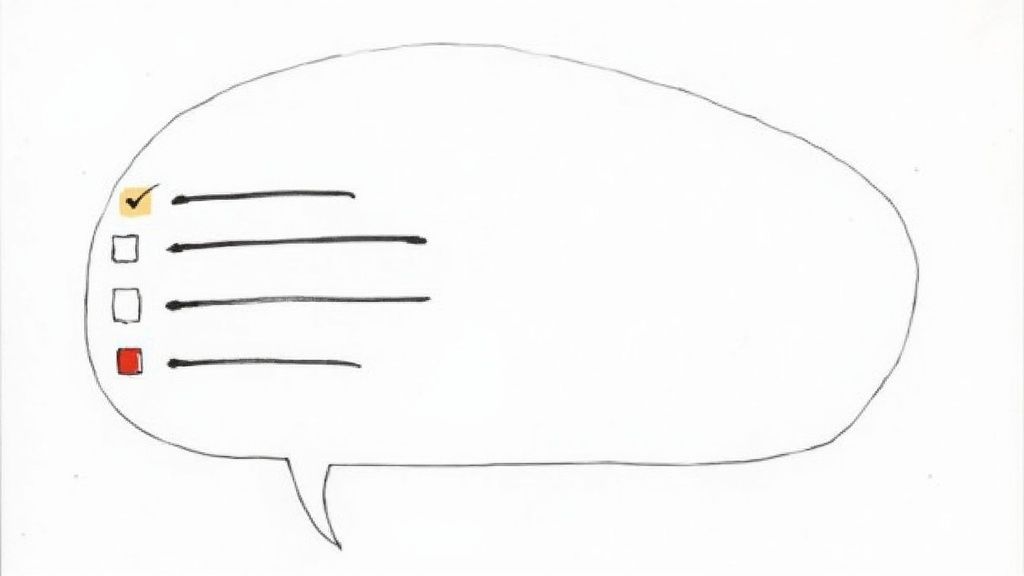
We’ll walk through a couple of the most common prompts and see what a strong, STAR-based response looks like. As you read, notice the collaborative language and how every story wraps up with a clear, positive business outcome. Think of these less as scripts and more as models to help you frame your own experiences.
Example for “Tell Me About a Time You Disagreed With a Coworker”
This one’s a classic. The interviewer is really asking if you can handle professional disagreements like an adult, without making it personal. Your answer needs to scream maturity, respect, and a laser focus on the end goal.
Here’s how you could tackle it:
Situation: “In my last role as a project coordinator, a senior designer and I were at odds over the UI for a new mobile app. He was pushing for a minimalist, text-heavy design he felt would be faster to build. I, on the other hand, had user data suggesting a more visual, icon-based interface would drive better engagement.”
Task: “My main job was to make sure this project hit its core objective: increasing user adoption by 15%. I had to navigate our creative differences without derailing the timeline or losing sight of that primary goal.”
Action: “I set up a one-on-one with him to really hear him out. I started by acknowledging his point about development speed, which was valid. Then, I pulled up the A/B test data from a previous project that showed a 20% higher click-through rate on visual elements. I suggested we quickly create two simple mockups and test them with a small user group before going all in.”
Result: “He loved the idea of letting the data decide. The user tests were overwhelmingly in favor of the visual design, and he ended up becoming its biggest champion. Not only did the app launch on schedule, but it crushed our goal, hitting a 22% increase in user adoption in the first quarter. Our working relationship got a lot stronger after that, too.”
Why This Answer Works
See what happened there? The story shifted the conflict from “my opinion vs. his opinion” to a professional, data-backed decision. This shows you take initiative, respect your colleagues’ expertise, and—most importantly—put the project’s success ahead of your own ego.
This approach is exactly what modern companies are looking for. A 2023 survey found that 59.8% of workers prefer a collaborative style for resolving workplace disagreements. That’s a huge signal that employers want team players who can find a win-win solution.
Example for “How Do You Handle Working With Difficult People”
This question is a bit of a landmine. Your first move is to sidestep the word “difficult.” Frame your answer around navigating different work styles or communication preferences instead. It shows way more emotional intelligence.
Key Takeaway: Never, ever bad-mouth a former colleague. Focus your story on the situation and the process you used to find common ground. This is a huge test of your professionalism.
Situation: “I once collaborated with a brilliant engineer who had a very direct, critical communication style. During team meetings, his feedback sometimes came off as purely negative, and I could see it was starting to affect morale and slow down our brainstorming.”
Task: “My goal was twofold: keep our team environment positive and productive, but also make sure we were still benefiting from his sharp technical insights. I needed to bridge that communication gap so everyone felt heard and respected.”
Action: “I decided to chat with him privately over coffee. I started by saying how much I valued his expertise and then asked for his ideas on how we could make our creative reviews more efficient. That opened the door to a conversation about communication styles. It turned out he was just intensely focused on solving problems quickly and had no idea how his tone was landing.”
Result: “After our chat, he made a real effort to frame his feedback more constructively. We also started a new team rule: begin all feedback by mentioning something you liked first. That tiny change had a massive impact. Our meetings became more collaborative, and we ended up cutting our revision cycles by about 30%.”
These examples should give you a solid blueprint for telling your own conflict stories with confidence. If you want to practice building out your own STAR answers, a tool like an Interview Answer Generator can be a great way to structure your thoughts and refine your delivery.
Answering for Senior and Leadership Roles
When you’re interviewing for a senior or leadership role, the game changes. The hiring manager’s expectations for how you handle conflict questions go way up. They aren’t just checking if you can manage a simple disagreement. They’re sizing you up to see if you can be a mediator, a facilitator, and a stabilizing force for an entire team.
Your stories need to reflect that bigger responsibility.
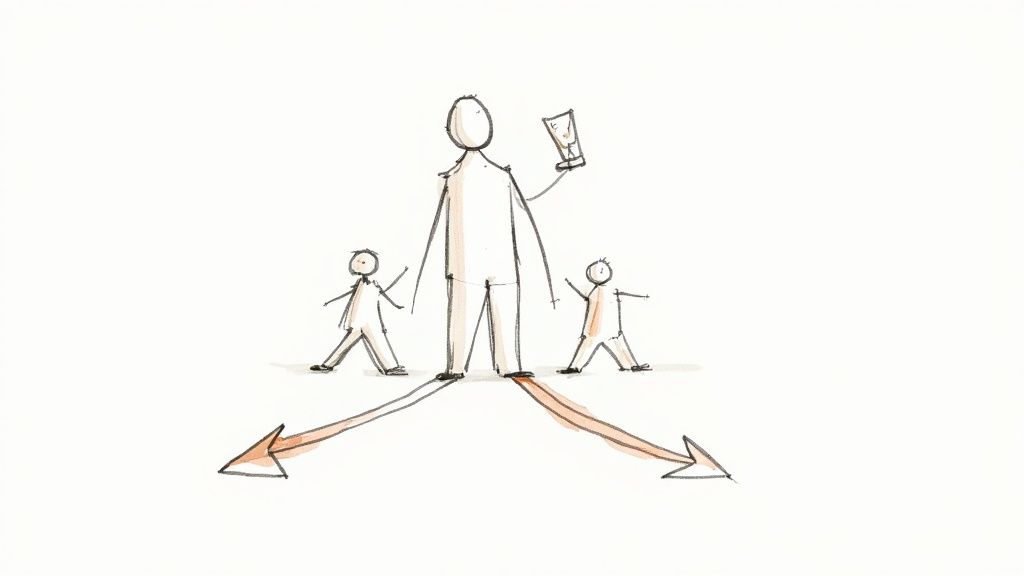
This means you should skip the stories about a one-on-one dispute with a colleague. Instead, pull out an example where you stepped in to resolve friction between team members, across different departments, or even with a difficult stakeholder. The focus shifts from your personal problem-solving to ensuring team-wide harmony and keeping projects on track.
Highlighting Leadership Competencies
Your answer is a golden opportunity to showcase core leadership qualities. Think beyond just “solving the problem.” Use your STAR method story to paint a picture of you as a leader who can:
- Foster Psychological Safety: Explain how you built an environment where your team felt safe enough to voice different opinions without worrying about personal attacks. This is huge for innovation.
- Facilitate Constructive Dialogue: Talk about the specific steps you took to get people talking. Did you set ground rules for a meeting? Guide the conversation back to shared goals? Get specific.
- Maintain Team Morale: The best answers show how your intervention didn’t just put out a fire but actually improved the team’s long-term health and ability to collaborate.
- Drive Towards a Resolution: Emphasize how you guided the team to a consensus or a clear decision that got the project moving forward again.
There’s a reason these questions are staples in management interviews. The Society for Human Resource Management (SHRM) even confirms that questions about managing coworker disputes are used to gauge a candidate’s emotional intelligence and leadership potential. You can read more about what they look for on SHRM’s executive network insights.
Leader’s Takeaway: Frame your conflict example as a strategic intervention. Your job wasn’t just to stop an argument; it was to turn a point of friction into an opportunity for team growth and a better project outcome.
Elevating Your STAR Method Example
When you’re telling your story as a leader, the “Action” part of the STAR method becomes the main event. Your actions shouldn’t be about your personal feelings. They should be about the strategic choices you made.
For instance, you might describe how you held separate, one-on-one meetings to hear each person’s side of the story before bringing them together. This isn’t just a nice thing to do; it shows a methodical, empathetic approach. It also hits on the core principles of great management, which we dive into in our guide on what is inclusive leadership.
Ultimately, your goal is to prove you can handle the messy, complex human dynamics that come with managing people. Show them you don’t just resolve conflict—you build stronger, more resilient teams because of it.
Common Questions About Conflict Scenarios
Even with the best preparation, a few tricky questions can throw you off your game. Let’s walk through some of the most common hurdles people face when talking about conflict in an interview so you’re ready for anything.
What If I Don’t Have a Major Work Conflict to Talk About?
This is way more common than you’d think, especially if you’re early in your career. If a big workplace showdown doesn’t come to mind, don’t sweat it. You can pull a relevant experience from an academic group project, a volunteer role, or even a tricky client interaction. What really matters is showing you can handle disagreements with professional maturity.
Just be sure to frame your story correctly. You could start by saying something like, “Thankfully, I’ve always been part of highly collaborative teams, but a situation that required similar problem-solving skills was…” From there, just launch into the STAR method like you would with any other example. The key is to focus on navigating a difference of opinion over ideas or processes, not a personality clash.
How Do I Talk About a Conflict Without Blaming Anyone?
The words you choose are everything. You want to sound objective and focused on the solution, not like someone who’s still holding a grudge. Use neutral language that takes the personal blame out of the story.
Instead of saying, “My coworker was totally disorganized,” you could try, “We had different approaches to managing the project’s timeline.” See how that little shift changes the whole vibe?
Your story should always come back to the shared goal. For instance, “We both wanted the launch to be a success, so I suggested we sit down and map out a workflow that played to both of our strengths.” This instantly positions you as a proactive collaborator, not a complainer.
After you’ve explained the disagreement, it’s a great idea to show you took steps to make things better for the future. Maybe you suggested clearer communication channels or helped clarify roles on the next project. Showing that kind of foresight proves you’re not just fixing a one-time issue—you’re actively improving the team’s entire process. For more on this, our guide on how to ask for feedback at work has some really useful strategies.
At Remote First Jobs, we’re here to help you find a role where your collaboration skills will be celebrated. Check out thousands of verified remote positions and discover your next great opportunity today.
